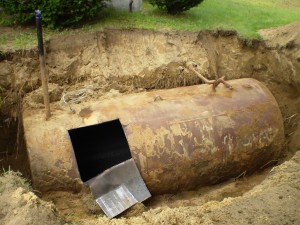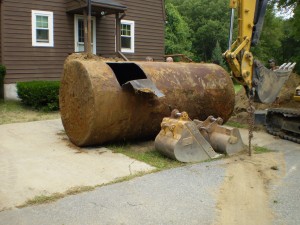A leaking underground storage tank (UST) can pose a serious liability issue for property owners, banks, and mortgage holders. Reviewing the potential for this type of liability is a principal component of an Environmental Site Assessment which may be performed prior to ownership transfer or refinancing of a residential, commercial or industrial property. At a minimum, prospective buyers and/or banks should insist that soil sampling be performed to protect their interests at a property where a UST is known to be present. Irrespective of the tanks contents, serious environmental damage can result from a leaking UST, associated piping or a supply line. Because most insurance companies only provide coverage for third party impacts (with the exception of properties such as retail gasoline stations), the financial burden of assessing and remediating a release can be significant. Where possible, Lingenfelter Environmental Consulting, LLC (LINEC) recommends that heating oil USTs and their associated piping be removed prior to the transfer of property ownership.
Removing a UST is not as simple as retaining the services of an excavation contractor. Property owners, and especially those seeking to buy property, should have soils and/or groundwater in the vicinity of a known UST tested to ensure there has been no leakage. Failure to do this leaves owners at risk of legal action from state and local agencies and potentially abutting property owners. Delaying cleanup after a reportable release has been discovered only compounds the problem and may potentially substantially increase cleanup costs. If a reportable leak/release has occurred, LINEC‘s LSP can determine the extent of contamination, develop the most cost-effective cleanup approach and submit the required documentation to the Massachusetts Department of Environmental Protection (DEP).

 Massachusetts environmental regulations require that the removal or in-place abandonment of a UST include an assessment as to whether or not a reportable release of contamination has occurred to the environment. These regulations apply to both residential and commercial properties. LINEC will work with your UST removal contractor or upon request, will assist you in retaining the services of an appropriate removal/excavation contractor. LINEC will provide UST removal oversight, including soil screening and sampling for confirmatory laboratory analysis. If the result of soil screening/sampling determines that a reportable release has not occurred, LINEC will prepare a letter report documenting the UST removal activities performed. If evidence of a reportable release is observed, additional assessment and/or cleanup may be necessary. LINEC will assist you with obtaining acceptance of petroleum contaminated soil (PCS) at a receiving facility for recycling/disposal, provide excavation oversight, collect soil samples for field screening and confirmatory laboratory analysis, coordinate excavation dewatering if necessary (due to changes in the NPDES program and the onerous requirements to obtain an RGP from EPA for the on-site treatment and discharge of contaminated groundwater, LINEC recommends that dewatering at most disposal sites include containment in a fractionating tank and off-site transportation for treatment, unless the dewatering project is small enough that the services of a vacuum truck will be sufficient), and preparation of the required Massachusetts Contingency Plan (MCP) submittals to DEP. LINEC will provide you with sufficient information to understand the available options to manage the specific environmental conditions observed at your property. LINEC provides its residential and commercial/industrial clients with plain language explanations and guidance through the complicated regulatory compliance process.
Massachusetts environmental regulations require that the removal or in-place abandonment of a UST include an assessment as to whether or not a reportable release of contamination has occurred to the environment. These regulations apply to both residential and commercial properties. LINEC will work with your UST removal contractor or upon request, will assist you in retaining the services of an appropriate removal/excavation contractor. LINEC will provide UST removal oversight, including soil screening and sampling for confirmatory laboratory analysis. If the result of soil screening/sampling determines that a reportable release has not occurred, LINEC will prepare a letter report documenting the UST removal activities performed. If evidence of a reportable release is observed, additional assessment and/or cleanup may be necessary. LINEC will assist you with obtaining acceptance of petroleum contaminated soil (PCS) at a receiving facility for recycling/disposal, provide excavation oversight, collect soil samples for field screening and confirmatory laboratory analysis, coordinate excavation dewatering if necessary (due to changes in the NPDES program and the onerous requirements to obtain an RGP from EPA for the on-site treatment and discharge of contaminated groundwater, LINEC recommends that dewatering at most disposal sites include containment in a fractionating tank and off-site transportation for treatment, unless the dewatering project is small enough that the services of a vacuum truck will be sufficient), and preparation of the required Massachusetts Contingency Plan (MCP) submittals to DEP. LINEC will provide you with sufficient information to understand the available options to manage the specific environmental conditions observed at your property. LINEC provides its residential and commercial/industrial clients with plain language explanations and guidance through the complicated regulatory compliance process.
If you suspect a UST located at an adjacent property is responsible for a subsurface release of petroleum (such as a fuel oil or gasoline storage tank) or another hazardous material (such as a degreasing solvent or dry cleaning fluid), LINEC recommends that a thorough environmental assessment be conducted on your own property. Although no discharge may have occurred on the adjacent property, it is a prudent business practice to hire a properly licensed firm to document existing conditions and help protect your property from future liability. If evidence of contamination is detected at your property and the source of release is demonstrated to be at a neighbor’s property, the MCP includes a provision which protects an innocent downgradient property owner or operator from the responsibility to cleanup that portion of a disposal site located on their property. After completion of the necessary documentation to establish that the source of a release of Oil or Hazardous Material (OHM) originated on an upgradient property (which may be as simple as a review of existing public records but may also require the performance of a subsurface investigation of an appropriate scope to address the specific observed environmental conditions), LINEC‘s LSP can prepare a Downgradient Property Status (DPS) submittal on your behalf. Although DPS status may be granted by DEP, based upon site specific circumstances, a downgradient property owner or operator may still be obligated to implement a management plan to prevent, eliminate, or minimize danger to health, safety, public welfare and/or the environment for that portion of the disposal site located on their own property.
If you are the owner or operator of a gasoline service station property at which a reportable petroleum release has occurred from an existing or former UST, or you are planning to upgrade/replace an existing UST system, LINEC can assist you with managing the release or documenting environmental conditions during the performance of site work. If an MCP disposal site already exists at your property, it may be necessary to perform remodeling, redevelopment, or other construction activities in accordance with a Release Abatement Measure (RAM) Plan (depending on the scope of work and site specific environmental conditions). LINEC‘s LSP can prepare a RAM Plan to fit your needs. LINEC‘s LSP also has extensive experience managing petroleum releases in accordance with the Massachusetts 21J Underground Petroleum Storage Tank Cleanup Program. In addition to preparing MCP submittals, LINEC can assist you with filing an initial 21J claim application, 21J reimbursement submittals, and the tracking of work performed under/in accordance with the 21J program.
Large development and brownfields redevelopment projects performed at former commercial/industrial properties often discover a forgotten/abandoned UST or buried drum(s) not identified by the Environmental Site Assessment performed prior to the initiation of work. If you are the owner or developer of a former commercial/industrial property and encounter a previously unknown UST or buried drum(s) after construction and/or redevelopment activities have been initiated, LINEC can assist you with managing the removal of the UST or drum(s).
If you are the owner of a multi-family residential property, apartment building, commercial building, or a municipality responsible for the operation of buildings (such as a schools), it is common to require the services of an environmental services company and/or an LSP in association with the scheduled replacement of a UST used to store heating fuel (#2, #4 and/or #6 fuel oil), a release of petroleum from a UST system, or redevelopment construction activities.
Commonly, residential property owners and small business owners are unexpectedly thrust into a situation where they may be facing the possibility of civil or criminal liability due to the discovery and/or occurrence of a reportable release of OHM. Dealing with a release from a UST is one of the most costly problems a homeowner or small business owner may face. A release to the environment is a liability, which may significantly reduce the value of your property.
There are many environmental consulting companies competing for your business in today’s highly competitive market place. To be aware of your options is a prudent business practice. Sometimes a small environmental consulting company located close to a disposal site and which is familiar with the local area, can provide more responsive and cost effective services than a larger or large nationally recognized firm.
If a reportable leak/release has occurred at your property, you suspect that your UST is leaking or your property is contaminated, LINEC is available to assist you in restoring the value of your property and keeping your costs to a minimum. Please feel free to contact LINEC with any questions you may have regarding your individual environmental consulting needs. Thank you for considering LINEC to provide environmental consulting services.
